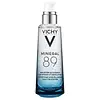What's inside
What's inside
 Key Ingredients
Key Ingredients

 Benefits
Benefits

 Concerns
Concerns

No concerns
 Ingredients Side-by-side
Ingredients Side-by-side

Aloe Barbadensis Leaf Juice Powder
Skin ConditioningWater
Skin ConditioningNiacinamide
SmoothingGlycerin
HumectantBifida Ferment Filtrate
Skin ConditioningCaprylic/Capric Triglyceride
MaskingCoco-Caprylate/Caprate
EmollientPrunus Amygdalus Dulcis Oil
Skin ConditioningSimmondsia Chinensis Seed Oil
EmollientDecyl Oleate
EmollientSaccharide Isomerate
HumectantCalanthe Discolor Extract
Skin ConditioningSodium Acetylated Hyaluronate
HumectantSodium Hyaluronate
HumectantSodium Hyaluronate Crosspolymer
HumectantHydrolyzed Sodium Hyaluronate
Skin ConditioningDimethicone
EmollientGlycine Soja Oil
EmollientSqualene
EmollientPalmitoyl Sh-Heptapeptide-12 Sp
Skin ConditioningCopper Palmitoyl Heptapeptide-14
Skin ConditioningHydrogenated Palm Glycerides Citrate
EmollientPentylene Glycol
Skin ConditioningXanthan Gum
EmulsifyingAcrylates/C10-30 Alkyl Acrylate Crosspolymer
Emulsion StabilisingSodium Hydroxide
BufferingDisodium EDTA
Tocopherol
AntioxidantGluconolactone
Skin ConditioningLactic Acid/Glycolic Acid Copolymer
Skin ConditioningCitric Acid
BufferingSodium Citrate
BufferingBeta-Sitosterol
Emulsion StabilisingPhenoxyethanol
PreservativeSodium Benzoate
MaskingEthylhexylglycerin
Skin ConditioningCaprylyl Glycol
EmollientGlyceryl Caprylate
EmollientPhenylpropanol
MaskingPolyvinyl Alcohol
Calcium Gluconate
HumectantParfum
MaskingAloe Barbadensis Leaf Juice Powder, Water, Niacinamide, Glycerin, Bifida Ferment Filtrate, Caprylic/Capric Triglyceride, Coco-Caprylate/Caprate, Prunus Amygdalus Dulcis Oil, Simmondsia Chinensis Seed Oil, Decyl Oleate, Saccharide Isomerate, Calanthe Discolor Extract, Sodium Acetylated Hyaluronate, Sodium Hyaluronate, Sodium Hyaluronate Crosspolymer, Hydrolyzed Sodium Hyaluronate, Dimethicone, Glycine Soja Oil, Squalene, Palmitoyl Sh-Heptapeptide-12 Sp, Copper Palmitoyl Heptapeptide-14, Hydrogenated Palm Glycerides Citrate, Pentylene Glycol, Xanthan Gum, Acrylates/C10-30 Alkyl Acrylate Crosspolymer, Sodium Hydroxide, Disodium EDTA, Tocopherol, Gluconolactone, Lactic Acid/Glycolic Acid Copolymer, Citric Acid, Sodium Citrate, Beta-Sitosterol, Phenoxyethanol, Sodium Benzoate, Ethylhexylglycerin, Caprylyl Glycol, Glyceryl Caprylate, Phenylpropanol, Polyvinyl Alcohol, Calcium Gluconate, Parfum
 Reviews
Reviews

Ingredients Explained
These ingredients are found in both products.
Ingredients higher up in an ingredient list are typically present in a larger amount.
Caprylyl Glycol is a humectant and emollient, meaning it attracts and preserves moisture.
It is a common ingredient in many products, especially those designed to hydrate skin. The primary benefits are retaining moisture, skin softening, and promoting a healthy skin barrier.
Though Caprylyl Glycol is an alcohol derived from fatty acids, it is not the kind that can dry out skin.
This ingredient is also used as a preservative to extend the life of products. It has slight antimicrobial properties.
Learn more about Caprylyl GlycolCitric Acid is an alpha hydroxy acid (AHA) naturally found in citrus fruits like oranges, lemons, and limes.
Like other AHAs, citric acid can exfoliate skin by breaking down the bonds that hold dead skin cells together. This helps reveal smoother and brighter skin underneath.
However, this exfoliating effect only happens at high concentrations (20%) which can be hard to find in cosmetic products.
Due to this, citric acid is usually included in small amounts as a pH adjuster. This helps keep products slightly more acidic and compatible with skin's natural pH.
In skincare formulas, citric acid can:
While it can provide some skin benefits, research shows lactic acid and glycolic acid are generally more effective and less irritating exfoliants.
Most citric acid used in skincare today is made by fermenting sugars (usually from molasses). This synthetic version is identical to the natural citrus form but easier to stabilize and use in formulations.
Read more about some other popular AHA's here:
Learn more about Citric AcidGlycerin is already naturally found in your skin. It helps moisturize and protect your skin.
A study from 2016 found glycerin to be more effective as a humectant than AHAs and hyaluronic acid.
As a humectant, it helps the skin stay hydrated by pulling moisture to your skin. The low molecular weight of glycerin allows it to pull moisture into the deeper layers of your skin.
Hydrated skin improves your skin barrier; Your skin barrier helps protect against irritants and bacteria.
Glycerin has also been found to have antimicrobial and antiviral properties. Due to these properties, glycerin is often used in wound and burn treatments.
In cosmetics, glycerin is usually derived from plants such as soybean or palm. However, it can also be sourced from animals, such as tallow or animal fat.
This ingredient is organic, colorless, odorless, and non-toxic.
Glycerin is the name for this ingredient in American English. British English uses Glycerol/Glycerine.
Learn more about GlycerinPhenoxyethanol is a preservative that has germicide, antimicrobial, and aromatic properties. Studies show that phenoxyethanol can prevent microbial growth. By itself, it has a scent that is similar to that of a rose.
It's often used in formulations along with Caprylyl Glycol to preserve the shelf life of products.
Sodium Hyaluronate is hyaluronic acid's salt form. It is commonly derived from the sodium salt of hyaluronic acid.
Like hyaluronic acid, it is great at holding water and acts as a humectant. This makes it a great skin hydrating ingredient.
Sodium Hyaluronate is naturally occurring in our bodies and is mostly found in eye fluid and joints.
These are some other common types of Hyaluronic Acid:
Learn more about Sodium HyaluronateWater. It's the most common cosmetic ingredient of all. You'll usually see it at the top of ingredient lists, meaning that it makes up the largest part of the product.
So why is it so popular? Water most often acts as a solvent - this means that it helps dissolve other ingredients into the formulation.
You'll also recognize water as that liquid we all need to stay alive. If you see this, drink a glass of water. Stay hydrated!
Learn more about Water